[Retracted] Prediction Model of Music Popular Trend Based on NNS and DM Technology
Abstract
The popular trend of today’s music can be obtained by deep excavation, analysis, and prediction of the audience’s preferences. Using huge music library resources and user behavior to form music big data and truly realizing the aggregation of audience preferences determine the popular development trend of music. Therefore, this paper will apply data mining (DM) technology, introduce neural network (NNS) theory, establish a prediction model of music fashion trend, predict and evaluate the music fashion trend according to the selected evaluation index, find the change of music fashion trend in time, and provide decision-making basis for music fashion trend. In this paper, the prediction of music popularity trend based on NNS and DM technology is studied. In the prediction of the number of songs played by 10 artists, the NNS algorithm proposed in this paper reduces the prediction effect from the original 0.074 and 0.045 to 0.044 and 0.032, respectively, and the error rates are reduced by 35.7% and 29.4%, respectively, compared with the learning algorithm and the decision tree algorithm. Among the three methods, the NNS algorithm in this paper has the highest accuracy. Therefore, it can be proved that the model proposed in this paper is more suitable for predicting the trend of music popularity. In the end, it can accurately control the trend of pop music and also realize the aggregation of user preferences to determine the trend of pop music.
1. Introduction
The development of pop music in today’s society shows a prosperous situation in which hundreds of flowers contend. Compared with the end of last century, the development of pop music since this century has favored traditional culture, which is one of the development trends of today’s pop music. Since the new century, the development of pop music in Hong Kong and Taiwan has become sluggish, and the number of influential singers has decreased. At the same time, the long-term isolation from the mainland has caused pop music in Hong Kong and Taiwan to show a sense of “root seeking” to tap traditional culture. Accurate prediction of music trends cannot only enhance the user experience and increase platform revenue but also improve the popularity of singers. Excavate the singers who will have unlimited prospects in the future, and further enhance the influence and economic benefits of the music platform. Therefore, it is of great significance for singers, music lovers, and online music platforms to accurately predict the pop trend of music using historical data. Internet music data has the characteristics of diversity and complexity, high dimension, large amount of data, fast change, strong real-time, and obvious time series. The existing music trend models and traditional statistical models are often difficult to effectively analyze the complex relationship between singers, users, songs (downloads, broadcasts, and collections), and other large amounts of data. The effect of deep mining of music data is not ideal.
As one of the products of entertainment consumption, pop music has attracted more and more attention. Whether there are songs that users like in the music platform is one of the necessary factors. With the foundation of users, we can talk about the diversified profit model. From the perspective of users, in addition to personal special preferences, the most popular and popular songs are most likely to be clicked. In the context of today’s big data, a large number of pop music listeners can determine the development trend of pop music to a great extent, which is mainly reflected in the impact of the behaviors of many listeners on major music platforms, such as audition, collection and download, on pop music, which reflects the audience’s preferences and preferences for corresponding music [1]. With the further development of major music platforms and music market scale, the gap of music library scale will gradually narrow, and the role of music library scale in user selection will be almost the same [2]. Who can better predict the popular trend of music and show its progressiveness, technicality, and intelligence will win users and market. The popular trend of today’s music can be obtained by deeply mining, analyzing, and predicting the preference trend of the audience. Make use of the huge music library resources and user behavior to form music big data. Through accurate big data analysis, we can effectively predict the trend of music, truly realize the aggregation of audience preferences, and determine the pop development trend of music [3].
Therefore, this paper will apply DM technology, introduce NNS theory, establish a prediction model of music fashion trend, predict and evaluate the music fashion trend according to the selected evaluation index, and find the change of music fashion trend in time. DM mainly combines traditional statistical analysis methods with machine learning, genetic algorithm, artificial NNS, visualization technology, and database technology in artificial intelligence [4, 5]. By mining useful information and knowledge, it can predict the future development trend and implement decision-making behavior of enterprises. Therefore, this paper uses NNS to study the prediction of music fashion trend and builds a model [6]. Although the NNS is the most widely used network at present, it still has many problems, the biggest of which is the convergence speed, and its training is difficult to master, especially when the network training reaches a certain level. NNS has been widely used in intelligent detection, nonlinear prediction, pattern recognition, robot control, and other fields [7].
Based on the NNS algorithm, a system for predicting music pop trend is constructed. This chapter designs and implements a music pop trend prediction system based on the NNS algorithm and describes the development and operation environment and structure design of the system in detail [8]. The prediction of pop music trend can be obtained by deep mining and analysis of audience preferences and preferences on the basis of massive user data. According to the actual needs of music pop trend prediction, it is divided into three prediction tasks. The NNS method is used for combined prediction, and the prediction results of single model and combined model are compared [9]. This paper mainly introduces the source and research significance of music pop trend prediction, analyzes the advantages and research status of regression prediction based on NNS and DM technology, explains the main work and contribution of this paper, and combs the organizational structure of the paper.
Research innovation lies in the formation of music big data with huge music library resources and user behavior.By mining the potential rules of user behavior, song information and artist information, select effective information for data cleaning, data integration and data transformation. This paper studies the prediction of music pop trend based on neural network and data mining technology. When predicting the number of songs played by multiple artists, the neural network algorithm proposed in this paper will reduce the error rate compared with the learning algorithm and the decision tree algorithm.
2. Research Status of Music Pop Trend Prediction
Gan proposed that with the development of science and technology and social productivity, we will predict the popularity and universality of music through information technology. This is a scientific and effective judgment basis for senior musicians who judge pop singers and predict dark horses based on rich personal experience [10]. Zhang proposed that since everyone’s favorite music may span several styles, various online radio stations need to collect most people’s preferences for different music, and they need to be divided into various types of music according to the style of pop music [11]. KS et al. proposed that Shazam is a music radar software that can identify the music and TV programs playing around you. It realizes song identification by collecting external song fingerprints and comparing them with server-side fingerprints [12]. Scott-Maxwell proposed that in Chinese pop music, Chinese elements tend to increase gradually. For example, traditional opera elements and classical elements appear in pop music, which makes China’s pop music get greater development, and the music elements in China’s pop music also begin to show a diversified development scene [13]. Liu et al. proposed that the music pop trend prediction competition held by Alibaba cloud is based on the powerful data computing ability of Alibaba cloud platform; through the user’s historical behavior data, predict the amount of artists playing in the next stage, and mine the artists who will become the focus of attention, so as to accurately control the pop trend of music in the future [14]. Lim et al., through the analysis of historical user behavior data, predict the playback volume of some artists or songs in the next stage, mine future dark horse singers from massive data, and fundamentally accurately control the development trend of pop music, which is the focus of many music platforms [15]. Canavan and Mccamley proposed that for ordinary users, the prediction of music pop trends can enable users to grasp the popularity of artists on the current music platform, understand the latest and future development momentum, and experience its progressiveness and development [16]. Guerra et al. put forward that the style and form of Chinese pop music are mainly influenced by Europe and America and gradually form a local style on this basis. In recent years, there has been a “Chinese style” in pop music. With the help of this element, musicians with different music styles have jointly expressed a trend closer to Chinese traditional elements, which makes pop music have a unique Chinese style [17]. Jung et al. propose a large number of pop music listeners can determine the development trend of pop music to a large extent, which is mainly reflected in the impact of the behavior of many listeners on the main music platforms, such as audition, collection and download, on pop music, which reflects the audience’s preference and preference for corresponding music [18]. Fautley suggests that with the further development of major music platforms and the scale of music market, the gap between the scale of music libraries will gradually narrow, and the role of the scale of music libraries in user selection will be basically the same [19].
In this paper, the neural network algorithm of data mining technology is used to study it, and the ringing factor of daily listening volume of songs is studied. It realizes song identification by collecting external song fingerprints and comparing them with server fingerprints. Shazam is a music radar software, which can identify the music and TV programs playing around you. Using data mining technology to analyze and study a large number of Internet music, data is one of the most concerned research points of Alibaba, Tencent, Netease, and other Internet companies. Data mining and data analysis are new research fields of data analysis and processing. On the basis of previous studies, this paper studies the prediction of music pop trend based on neural network and data mining technology. At the same time, the exponential smoothing method and autoregressive moving average model are used to predict the number of song auditions, and the prediction results of different algorithms are compared in order to complete the preskill training of daily listening capacity of songs.
3. DM Process Based on NNS
Before using DM technology to predict the stock price trend, it is necessary to determine the general process of DM. Combined with the characteristics of NNS DM technology, DM based on NNS is determined. NNS not only has very flexible nonlinear modeling ability but also has strong parallel processing, self-learning and adaptive, computational optimization, associative memory, and other abilities [20, 21]. Therefore, NNS has been widely used in many fields, such as intelligent detection, nonlinear prediction, pattern recognition, and robot control. At present, the research of NNS has become more and more mature, and its application is more and more extensive. By understanding the data of users’ listening behavior, analyzing, and processing the data and using it, enterprises with Internet music platform can greatly improve their competitiveness in occupying market share [22]. By using DM technology to analyze the user data of music platform, we can get the information about users’ listening orientation and hobbies, so it provides a favorable basis for business decision-making. It iterates through multiple cycles of the two processes through DM technology. Each iteration is an epoch. The weight is randomly set before the start. The algorithm passes through the cycle and stops after reaching the conditions.
The NNS algorithm adopts the gradient descent method, and the training is to gradually reach the minimum value of the error along the slope of the error function from a certain starting point. For complex networks, the error function of DM technology is the surface of multidimensional space, and there are many Valley points. The difference method is an approximate numerical solution of differential equations. Specifically, the difference method is to replace the differential with finite difference and the derivative with finite difference quotient, so that the basic equations and boundary conditions (generally differential equations) are approximately expressed by difference equations (algebraic equations), and the problem of solving differential equations is changed into the problem of solving algebraic equations. In elasticity, the difference method and variation method are used to solve plane problems. This DM technology cycle includes two stages: forward and backward. In the forward phase, neurons are activated in the process of input to output, and the output signal is generated by using the weight and activation function of each neuron until the last layer. In the backward stage, the output signal generated in the forward stage is compared with the actual value, the error between the output signal and the real value is back propagated, and the weight value is corrected to reduce the error. The flow of NNS algorithm is shown in Figure 1.
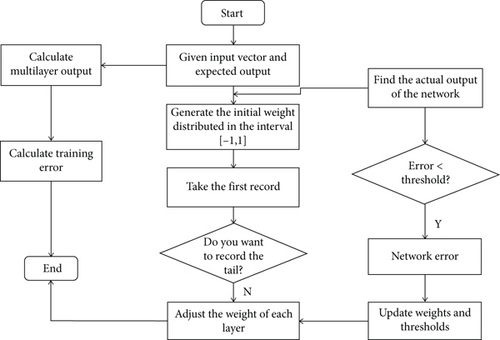
The NNS algorithm adopts the steepest descent method of data. Theoretically, its training is approaching downward along the slope of the error surface. For a complex network, its error surface is a surface in a high-dimensional space, in which there are many local minima. Once it falls into such local minima, it is difficult to escape with the current algorithm. During the execution of the NNS algorithm, the amplitude of each adjustment of the weights is made by multiplying a term proportional to the network error function or its derivative to the weights by a fixed factor 1r. In this way, when the error surface is flat, because the deviation value is small, the adjustment range of the weight is relatively small, so that the error function surface needs to be adjusted several times by DM technology. However, in DM, the curvature of the error surface is higher, the partial derivative value is larger, and the adjustment range of the weight value is larger, which may lead to overshoot near the minimum point of the error function, and it is difficult to converge to the minimum point.
In this context, the purpose of this DM is to establish a NNS model according to the prediction characteristics of music pop trend. On this basis, the effectiveness of the model prediction is proved through empirical research, which shows the advantages of the prediction method based on NNS in the prediction of music pop trend. When the NNS model was published, it did not give a learning algorithm to adjust the connection weight between neurons [23]. However, we can use some common algorithms to adjust the neuron connection weight according to the needs to achieve the purpose of learning. NNS is a widely used forward NNS model, which can train a NNS model that meets all training sets as much as possible according to different inputs and outputs. At this time, a large amount of weight modification is required, but in fact, because the derivative value approaches zero, the amount of weight modification is very small, so learning is slow. The same is true for hidden layer neurons. Once learning enters the “false saturation” state, it takes a long time to get rid of this state. The NNS is composed of three or more layers of neurons. The neurons in the same layer are not connected with each other, and only the upper neurons can connect the lower neurons. The NNS model is shown in Figure 2.
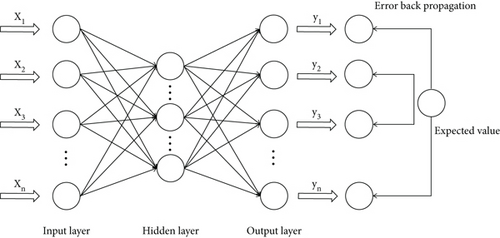
Normalize the data to between [0, 1] and [-1, 1].
The approaching progress of the NNS algorithm in the next step and the standard NNS algorithm needs many steps to achieve. In the attenuation oscillation stage, because it is closer to the minimum error point and the attenuation oscillation decays very fast, the approximation degree achieved by the unit NNS algorithm by attenuating the oscillation every two steps can only be achieved by the standard NNS algorithm after many steps. Under the DM technology, the NNS algorithm is used to analyze the historical data of music and audience, and the more accurate prediction of music pop trend is realized. Based on the existing research, this paper will further explore and innovate the prediction of music pop trend.
4. Research on Prediction of Music Pop Trend
4.1. Data Statistical Processing
This experiment uses the competition data in the Ali music pop trend prediction competition from April 1, 2021, to September 1, 2021. The data is from the operation record data of real users in the application of Ali music platform. Song_id represents the ID of the song and the unique identifier of the song. Artist_id refers to the ID of the artist and the unique identifier of the artist. Public_time indicates the release time of the song. Song_init_plays indicates the initial number of times the song is played, that is, the initial heat. Language indicates the language type of the song. Gender indicates the artist’s gender. This data records the operation records of a large number of users on all songs of 100 artists. The data includes two parts: recording the data of songs and recording the user’s operation records of songs. The data of recorded songs are shown in Table 1.
| Song_id | Artist_id | Public_time | Song_init_plays | Language | Gender |
|---|---|---|---|---|---|
| c81f89cf7edd24930641afa2e411b09c | 03c6699ea836decbc5c8fc2dbae7bd3b | 20210425 | 0 | 120 | 1 |
| cOd7130777c1f1c417e78646946ed909 | 03c6699ea836decbc5c8fc2dbae7bd3b | 20210426 | 1341 | 130 | 1 |
| … | … | … | … | … | … |
This experiment recorded all songs of 120 artists, with a total of 26,987 records. Each record contains basic information such as song ID, artist ID, song release time, and artist gender. User_id indicates the user id that generates the operation record, which is the unique identifier of the user. Song_id represents the song ID, the unique symbol of the song. Gmt_create indicates the timestamp of the record. Action_type indicates the type of user operation, 1 indicates audition, 2 indicates download, and 3 indicates collection. ds indicates the date when the record was generated. Records of the user’s operation of songs are shown in Table 2.
| User_id | Song_id | Gmt_create | Action_type | ds |
|---|---|---|---|---|
| 7063b3dOc075a4d276c5f}6f4327cf4a | effb071415be51fl1e845884e67cOf8c | 1426405100 | 2 | 20210316 |
| Odb66cOdd3993fd3504bb98c3beb15b3 | f87ff481d8Sd2f}5335ab602f38a7655 | 1426416800 | 2 | 20210316 |
| … | … | … | … | … |
Tables 1 and 2 record the operation records of 26,987 songs of 120 artists by all users from April 1, 2021, to September 1, 2021. The data in these two tables cannot be directly used to predict the amount of songs that artists listen to every day in a certain period of time. It is necessary to first make statistical analysis of the data, then build the corresponding data set, and finally use the prediction-related algorithm to build an algorithm model for prediction.
Count the daily audition, download, and collection of each song. Create a new statistical table in the database. The format is shown in Table 3.
| Field name | Type | Field length | Remarks |
|---|---|---|---|
| Song_id | Varchar | 254 | Song ID |
| Action_type | Varchar | 254 | User action type |
| ds | Varchar | 254 | Date |
As can be seen from Table 3, use SQL statements to count the data in the above table format and insert the statistical data into the table. For SQL statistical statements, please refer to the following: insert into songsta select count num, DS, song ID, action type from P2 Mars t ianchi user actions group by DS, song ID, and action type. After the above SQL is used to insert statistical data, the table contains 1,663,653 pieces of data.
4.2. Experimental Result
This experiment is aimed at the average number of songs played, downloaded, and collected by singers in the past six months. The test results are shown in Figure 3.
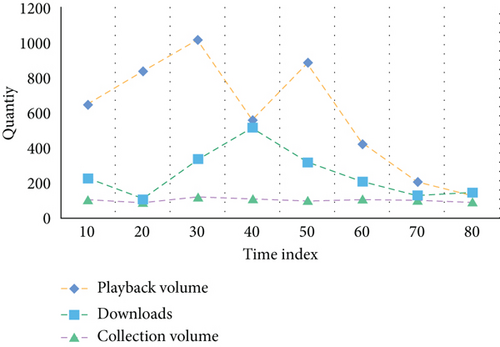
As can be seen from Figure 3, among the songs played, collected, and downloaded by a certain singer, the best one to predict whether a certain singer will be popular in a certain period of time in the future is the playing volume.
According to the song playing data of all singers, the mean value is removed, the variance is normalized and scaled to [-1, 1], and the length of mean filter is set to ave Filter = 4. The prediction curve shown in Figure 4 can be obtained by using the original playback volume for prediction.
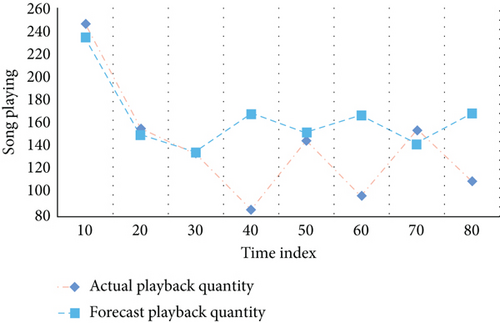
It can be seen from Figure 4 that there is a deviation in the prediction of some singers in the results of the prediction of the original data. The reason may be that the data collected by establishing the prediction model is not comprehensive or accurate, resulting in the deviation of the prediction results. The defect of mathematical model itself. Therefore, the main purpose of this chapter is to predict the daily song audition volume of artists in a certain period of time through the prediction algorithm, so as to find the artists with higher song audition volume according to the pre measurement.
In this experiment, 10 artists are randomly selected in the data set, and the number of artists’ songs from July 1, 2021, to September 1, 2021, is predicted by using the machine learning algorithm, decision tree algorithm, and NNS algorithm. The prediction results root mean square error, average absolute error, and accuracy are shown in Figure 5–7.
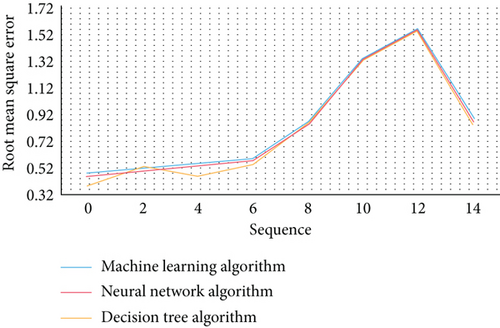
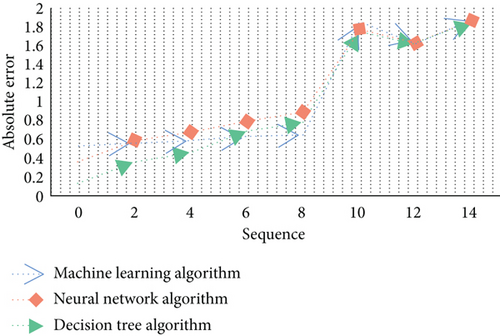
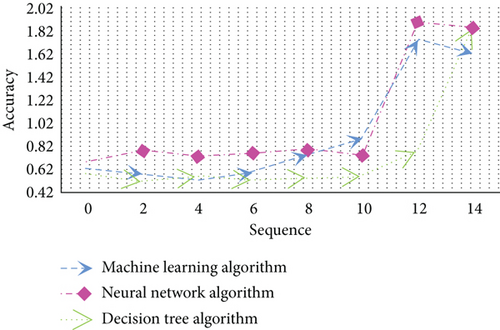
It can be seen from Figures 5–7 that in the prediction of the number of songs played by 10 artists, the prediction effect of the NNS algorithm proposed in this paper is reduced from 0.074 and 0.045 to 0.044 and 0.032, respectively, and the error rate is reduced by 35.7% and 29.4%, respectively. In addition, among the accuracy of the three methods, the NNS algorithm in this paper has the highest accuracy. Therefore, it can be proved that the model proposed in this paper is more suitable for predicting the trend of music popularity.
Accurate prediction of music trends can enhance user experience and increase platform revenue. It can also improve the popularity of singers and dig out singers who have unlimited prospects in the future . Therefore, it is of great significance for singers, music lovers, and online music platforms to accurately predict the pop trend of music using historical data.
5. Conclusions
In this paper, the prediction of music popularity trend based on NNS and DM technology is studied. In the prediction of the number of songs played by 10 artists, the NNS algorithm proposed in this paper reduces the prediction effect from the original 0.074 and 0.045 to 0.044 and 0.032, respectively, and the error rates are reduced by 35.7% and 29.4%, respectively, compared with the learning algorithm and the decision tree algorithm. Among the three methods, the NNS algorithm in this paper has the highest accuracy. Who can better predict the popular trend of music and show its progressiveness, technicality, and intelligence will win users and market. The popular trend of today’s music can be obtained by deeply mining, analyzing, and predicting the preference trend of the audience. Make use of the huge music library resources and user behavior to form music big data. The potential rules of users’ behaviors, song information, and artist information are mined, and effective information is selected for data cleaning, data integration and data conversion. The construction speed of NNS model needs to be further improved. Due to the limited experimental environment, it is impossible to realize parallel computation of NNS algorithm through cloud platform, which leads to the time-consuming training of NNS algorithm, and the whole prediction process is slightly slower. The prediction of pop music trend can be obtained by deep mining and analysis of audience preferences and preferences on the basis of massive user data. However, the research still has some limitations. The study did not discuss and analyze the probability that the prediction deviation and the deviation are different. Including incomplete feature sets, biased training samples, and chaotic data sets. Therefore, further discussion and analysis are needed in future research.
Conflicts of Interest
The authors declare that they have no known competing financial interests or personal relationships that could have appeared to influence the work reported in this paper.
Acknowledgments
This work was supported by Nanchang Hangkong University: Research on Artificial Intelligence Composition Based on Deep Neural Network (No. YG2021021).
Open Research
Data Availability
The data used to support the findings of this study are available from the corresponding author upon request.




